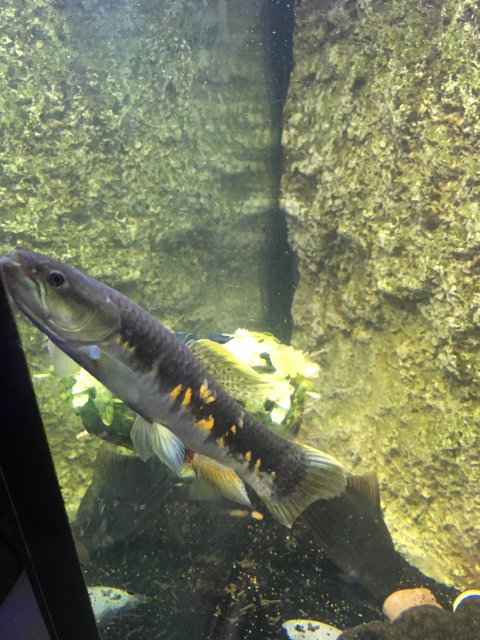Just got home from my work rotation in the north; all looks good with the wolffish and others. The wolf is noticeably longer and has filled out nicely compared to the emaciated waif I brought home. Colour is starting to develop, with some smallish patches of orange becoming visible. He's nothing like the beautiful pics shown here and elsewhere of fully grown specimens, but it looks hopeful.
Having kept assorted large predatory catfish, snakeheads, aros and others over the years, I am somewhat surprised at this fish's almost delicate approach to swallowing food. His attack is swift and direct, but food items like large guppies, large chunks of krill, earthworms, large pellets, etc seem to require quite a lot of chewing, shaking and dismemberment before he swallows the smaller resulting pieces. An earthworm that would be immediately gulped down by a snakehead or bowfin of similar size to this fish, requires many minutes of this abuse before finally going down the hatch...in chunks. I'm going to be careful to provide small enough food items to minimize chances of choking, and also to reduce the amount of particulate and liquid waste being squeezed into the water.
Having said that, this fish is far, far easier to wean onto dead/frozen/prepared foods than many other predators. I've never really had difficulties switching most of them to non-living food items, but depending upon the species there was usually a period of training and familiarization required. Methods of presentation had to be perfected in order for the switch to be painless and effective; although once a predator is "broken" to frozen and/or pelleted foods, it's usually a done deal and feeding is easy after that point.
With this guy, no effort required. Once he overcame his initial fear and shyness, feeding was pretty much a matter of throwing something in and watching him eat it. In addition to natural foods like small fish, krill (frozen or freeze-dried) and earthworms, he readily takes any pellet of the appropriate size, either floating or sinking. Locating food is obviously done by scent (the introduction of food brings him out of his lair very quickly, assuming that opening the lid hasn't already done that) and also by sight. He homes in quickly on floating pellets, despite the fact that the surface is largely covered by duckweed; and sinking pellets that have not been seized on the way down are approached with confidence and plucked off the bottom or wherever they lay.
If anyone were to doubt that the fish has and utilizes excellent eyesight for hunting, all that needs be done is to quietly enter the fishroom and then shine a laser-aimed remote temperature sensor into or near the tank. When hiding, he is obviously keeping an eye on his surroundings from his place of concealment; that dancing red dot elicits an immediate attack response and he pursues it avidly, and watches it intently if it is shining on a surface outside the tank. I've never had a fish react that way, but in fairness I only got one that cool little laser toy recently.

Maybe tech isn't evil; gotta get a digital camera soon and start taking pics of aquarium fish, something my phone just won't do very well.





